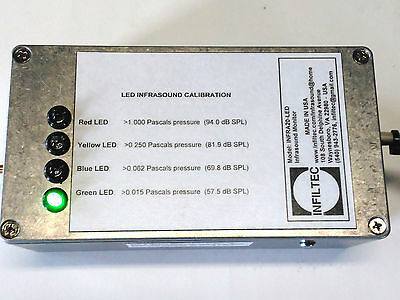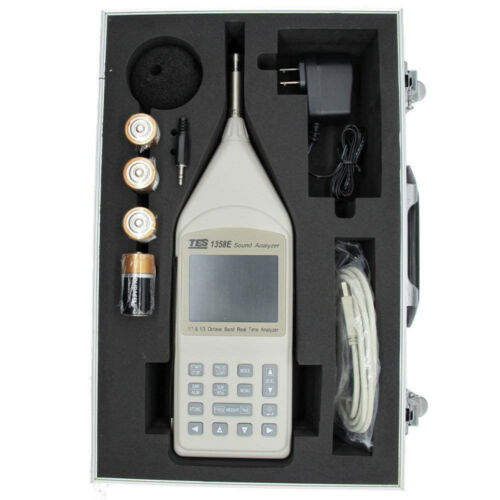-40%
Infiltec Model INFRA20-LED Infrasound Monitor,USB Adapter,Data Logging Software
$ 234.96
- Description
- Size Guide
Description
The Infiltec Model INFRA20-LED infrasound monitor with LED intensity indicators is designed to datalog, display and analyze infrasound below the human hearing range in the 0.05 Hz to 20 Hz range. Infrasound is produced by wind turbines, helicopters, meteors, avalanches, volcanoes, large animals like elephants, etc. The INFRA20-LED is designed to provide infrasound monitoring for lab, home, school and field use in a compact, portable, and rugged package that is less expensive and easier to use than conventional designs. The INFRA20-LED does not require any power supply or assembly or enclosure or adustment; including alignment, damping, zeroing, etc. The INFRA20-LED works with the standard AmaSeis Windows based software, and with the new jAmaSeis software for Windows, Linux and Mac OS. The Infiltec Model INFRA20-LED includes all the functions of the Infiltec Model INFRA20, plus it has added LED indicators, and a 9 volt battery connection for operation with the LED display but without a PC serial connection for data logging.For laboratory, field, school, office, or home use to record and analyze infrasound. This infrasound monitor comes with a 15 ft (4m) serial cable, 15 ft (4m) of 1/8 inch ID plastic tubing, a USB-Serial adapter, and a CD containing Windows software and software manual. 4 LED indicators indicate infrasound intensity: Green @ 0.015 Pascal (57.5 dB SPL), Blue
@ 0.062 Pascal (69.8 dB SPL),
Yellow @ 0.250 Pascal (81.9 dB SPL),
and Red @ 1.000 Pascal (94.0 dB SPL).
Detects infrasound in the 0.05 Hz to 20 Hz band that is generally inaudible to the human ear. Applications include monitoring wind turbines, machinery noise, building noise, elephants and other large animals, meteors, avalanches, volcanoes, earthquakes, cryptozoology studies of big foot and sasquatch, and paranormal investigations.
Requires an attached PC to log and display infrasound data, but other programs can run on PC while the infrasound data logging program is running. Works with Windows XP and above. The seismic data logging and analysis program AmaSeis is supplied on CD. Also runs with the new jAmaseis seismic software that runs on Windows, Linux and MAC OS.
The INFRA20
-LED
is not very sensitive to vibration or orientation, but it is very sensitive to temperature changes or altitude changes. Serial extension cables up to 100 ft can be used to connect it to the data logging PC.
The infrasound sensor is a differential pressure sensor with 1/8 inch ID tubing connection that is located on the side of the box that allows for tubing to be used to separate the monitor from the infrasound sensing location. The monitor is self adjusting, and never needs alignment, zeroing, leveling, or any other adjustments. No external power supply required. Setup takes minutes. Resolution is 0.001 Pascal (0.01 microbar). Range is ±25 Pascals. Sampling rate is 50 sps. Serial output data format is 9600bps, 8N1, 16 bit ASCII. A 9 volt battery connection is provided so that the unit can operate up to 50 hours on a fresh alkaline 9v battery without any PC serial connection for data logging (battery not included with monitor).
VIEW CURRENT
INFRA
20 REAL-TIME INFRASOUND DATA IN 24 HOURS DISPLAY:
Each horizontal line shows infrasound intensity over 1 hour. The vertical axis is infrsound intensity and the horizontal axis is time (0-60min). The most recent hour is at the bottom. This 24 hour infrasound display is updated every 5 minutes and is generated by an INFRA20 that runs 24/7 inside the Infiltec factory warehouse. The display was generated by the free AmaSeis seismic data logging/display software and the display updates are sent to the web by Fling FTP software. You can set up a similar online display with your INFRA20 on your PC by using the same software.
Click on display image to enlarge and update.
Even though this INFRA20 is inside a building, it can detect the infrasound outside the building.
The daily oval shaped infrasound peaks (about 3 minutes long) come from freight trains as they pass within about 100 meters several times per day.
The occasional rectangular infrasound peaks (about 20 minutes long) during cold weather come from our building heating system fan cycling on and off.
The short infrasound spikes are generally caused by doors in the factory being opened and closed.
Wind is the most common infrasound background noise, and it generally peaks during the daylight hours (11-24 UT hours). You can check the local weather and wind
here
to see if it is windy at the monitor location.
The hours on the left side of the display are in
Universal/GMT time
that is +4 or +5 hours ahead of the local USA EST. The data logging time base is corrected within milliseconds by the free PC program
NetTime
.
APPLICATIONS OF THE INFRA20-LED:
Wind turbine monitoring.
Animal monitoring, including elephants, hippos, rhinos, giraffes, tigers, alligators, certain birds, etc.
Earthquake and tsunami monitoring.
Bolide or detonating fireball meteor monitoring.
Volcano monitoring.
Avalanche monitoring.
Thunder, lightning and severe weather monitoring.
Sonic boom monitoring.
Explosion monitoring.
Aurora monitoring.
Alleged haunted site or ghost monitoring.
Rotating equipment monitoring.
Sick building analysis.
Environmental assessments.
Microbarom monitoring.
Helicopter monitoring.
Tornado monitoring.
FEATURES AND BENEFITS OF THE INFRA20-LED:
10 second hardware setup! Take it out of the shipping box, plug it into your PC, and recording starts. (This assumes that
AmaSeis
software is installed and running)
Works with free AmaSeis seismic Windows software that provides data logging, 24 hour display, spectral analysis, bandpass filtering, etc.
No assembly ever required.
No damping adjustments ever required.
No external power supply ever required.
No leveling adjustments ever required.
No alignment ever required.
No adjustments for moving ever required, just pick it up and move it.
No adjustment of internal electronics (amplifier, filter, digitizer, power supply) ever required.
Practically indestructible to damage caused by shock, vibration, shipping & handling.
One enclosure contains everything: sensor, amplifier, filter, digitizer, power supply.
Metal enclosure shields electronics against noise from nearby electromagnetic interference.
High digital resolution (16 bits) keeps large and small infrasound events on scale.
Elliptic low-pass filter cutoff (8 pole) allows slow sampling output (50 sps) without aliasing.
Microprocessor firmware adjusts for component drift due to temperature changes, aging, etc.
Very low power (under 0.05 Watts) operation. Designed to operate continuously 24/7.
Connects to PC DB9 serial port, or a USB port through a USB-Serial DB9 adapter.
The INFRA20-LED model has 4 colored leds mounted in the top of the case that continuously
indicate infrasound intensity: Green @ 0.015 Pascal (57.5 dB SPL), Blue
@ 0.062 Pascal (69.8 dB SPL),
Yellow @ 0.250 Pascal (81.9 dB SPL),
and Red @ 1.000 Pascal (94.0 dB SPL).
The INFRA20-LED model has a 9 volt battery connector that can be used to power the unit for up to 50-70 hours on an alkaline 9v battery (not included) even if the unit is not connected to a PC via a serial cable for data logging.
Works on Windows 98/XP/Vista/7/8/8.1/10 PC via AmaSeis logging data 24/7 in background. You can use your PC for other jobs while AmaSeis is running.
SPECIFICATIONS FOR THE INFRA20-LED
Performance:
Resolution is 0.001 Pascals (0.01 microbar or 0.0075 millitorr) over the range of + or - 25 Pascals (250 microbars or 187.5 millitorr).
Mode of Operation:
Microbarograph design with solid-state differential pressure sensor and high-pass pneumatic filter.
Output:
Serial output formatted for
AmaSeis
seismic software, RS232 9600 baud N81 ASCII, 50 samples/second.
Frequency Pass-Band:
0.05 Hz to 20.0 Hz bandwidth digitized and stored on hard drive by AmaSeis at about 10 megabytes per 24 hours of operation.
Temperature Range
40 to 90 F (4 to 32 C) with no adjustments required. Internal firware automatically adjusts for drifts. Requires constant temperature during operation that can be provided by insulation such as a small lunchbox type cooler.
Housing:
Diecast aluminum box encloses all electronics and sensor, 6.024x3.268x1.988 inches (153x83x50.5 mm). Shipping weight 2.2 lb (1 kg).
Computer Connection:
15 ft (4.5M) serial cable (up to 100 ft (30M) extension optional) connects to PC DB9 connector or USB-Serial DB9 adapter.
Adjustments:
No leveling, alignment, damping, gain, zeroing, etc adjustments required.
Power Supply:
No external power supply required if connected to PC, all power (under 0.05 Watts) is supplied by PC serial/USB port through the serial cable/USB adapter connected to the PC.
Battery Power:
9 volt battery connector included that can be used to power the unit and LEDs for up to 50-70 hours on one fresh alkaline 9v battery (not included) even if the unit is not connected to a PC via a serial cable for data logging.
Digital Processing:
16 bits voltage resolution from internal digitizer, 50 sample/second ASCII output, firmware adjusts for component drifts.
LEDs
:
indicate 4 levels of infrasound intensity: Green @ 0.015 Pascal (57.5 dB SPL), Blue
@ 0.062 Pascal (69.8 dB SPL),
Yellow @ 0.250 Pascal (81.9 dB SPL),
and Red @ 1.000 Pascal (94.0 dB SPL).
Lowpass Filter:
Very steep analog 8 Pole elliptic filter with 20 Hz corner frequency for anti-aliasing.
Software:
Windows PC based seismic data logging and analysis software
AmaSeis or jAmaSeis
available online for free download. Includes spectral analysis and bandpass filtering functions.
Wind Reduction Firmware:
Switch selectable microprocessor firmware high pass filtering to reduce low frequency wind noise at the low end of the infrasound frequency band. Circuit board switches can select cutoffs at 2.0 Hz (default for most reduction), 1.0 Hz, 0.5 Hz, or 0.25 Hz (for least wind noise reduction).
Computer Requirements:
PC running Windows (98/XP/V/7/8/8.1/10) can run AmaSeis in backgound while doing other tasks. Hard drive that can store 10 megabyte/day during 24/7 operation. DB9 serial port or USB port for USB-Serial adapter (included).
SAMPLE DETECTIONS BY AN INFRA20 SYSTEM:
Here some INFRA20 infrasound (0.01-20Hz) detections from the Washington, DC area where helicopters fly over several times daily:
Click here
for a typical 24 hour AmaSeis display on a calm day. The red outline is around a typical helicopter infrasound signal with two other helicopter signals next to it. The green outline is around typical wind noise data. And the blue outline is around a typical spike signal for a door closing in the adjacent building.
Here is the red outline
helicopter infrasound signal
expanded AmaSeis display. Note the peak amplitude is about 1000 counts which corresponds to 1 Pascal (10 microbars) because the INFRA20 resolution is 0.001 Pascal (0.01 microbar) per count.
Here is the AmaSeis power spectra
of the red outlined helicopter infrasound signal. The power peak is around 17 Hz but it is spread out because of +/- doppler shift as the helicopter goes by. Note the steep roll off of the 8 pole elliptic 20 Hz low pass filter used in the INFRA20 for anti-aliasing.
UNDER DEVELOPMENT: A Portable Infrasound Generator
.
Precise digital tuning within the 8 to 20 Hertz output in the Infrasound Range.
Controlled by a built-in variable frequency generator and driven by a powerful subwoofer amplifier
Powered by either house current 110-240 VAC or 12 VDC car battery
Portable by truck or van
Design follows Helmholtz resonator principles
Inexpensive compared to other speaker designs
Driven by powerful subwoofer speaker
Potential applications include: music augmentation, classroom/public demonstrations, evaluations of effects on people and animals, repelling birds, propagation studies, paranormal research, etc.
Picture of prototype during testing (click on image to enlarge)



















